The purpose for constructing and managing entity hierarchies within MDM is to establish and model relationships from an entity to other entities. This provides a view of entity relationships at a particular point in time. There are many reasons for this, some of which are to drive operational activities for procurement, sales, marketing, and financial reporting in applications external to MDM.
Customer & Supplier Hierarchies
The purpose for a hierarchy in MDM is for proper grouping of customers or suppliers. The avenues for application include an internal view and an external view.
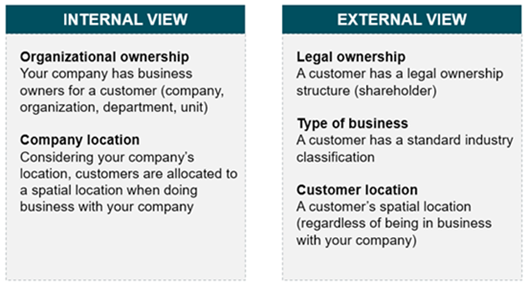
With internal view, organizational ownership shows business owners as the customers and allocate customers to actual locations when doing businesses with your company. This affords a view from your own company’s perspective as well as the ability to group customers according to your internal structure.
With external view, the customer has a legal ownership structure, works as a standard industry classification, and it shows the customer location, without regard to the company's location. This affords a view on customers from their company’s perspective.
Constructing Hierarchies
There are three primary methods of constructing a customer hierarchy in STEP:
- Manually - This is the approach delivered with the implementations package configurations.
- Import - Relevant reference types and parent ID's can be loaded via an import to construct hierarchies based on external data.
- Business logic - D&B could potentially be leveraged to construct hierarchies based on linking of DUNS number and parent DUNS.
Hierarchy Benchmark
When considering recommended practices in constructing customer hierarchies, customers must pass the 'is grouped by' test. This is a general analysis of grouping based on common characteristics. Some examples of characteristic groupings are as described in the following sections.

Organizational Characteristics
Organizational hierarchies may be characterized by customers that are owned by the same organizational unit, such as with a Financial or Sales organization. Organizational hierarchies are typically used by the business to organize customers according to the organizational setup of their company (division, sales organization etc.) and may also be used in sales transactions, revenue reporting, and/or commissioning. The same customer may also be referenced in different locations within this hierarchical structure.
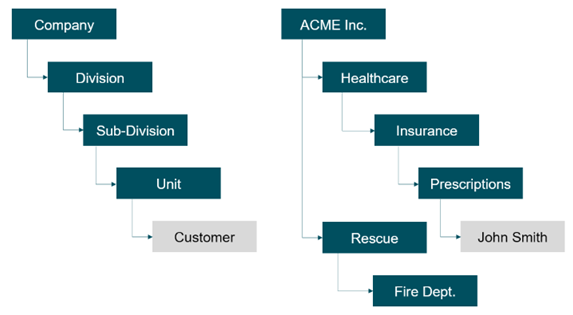
A division is regarded as an organizational unit for sales and distribution with a specific product portfolio to a customer. For every division, customer-specific agreements can be made like for partial deliveries, pricing, and terms of payment. A division can create an exclusion list of products for other divisions which can only be sold to a customer from that division.
In large organizations, one or more divisions may be responsible for a customer, such as if the company is selling cleaning equipment such as disinfectant dispensers (healthcare division) and laundry machines (textile care division) to the same hospital.
Legal Characteristics
Legal hierarchies may be characterized by customers that are owned by the same legal entity. Legal hierarchies are typically used by the business to categorize customers according to legal ownership, i.e., between holdings and subsidiaries and/or shareholders. A common usage is for legal reporting and analytics such as whitespace, risk analysis and credit checks (ex. roll up from subsidiary to holding). The same customer is not typically placed under different locations.
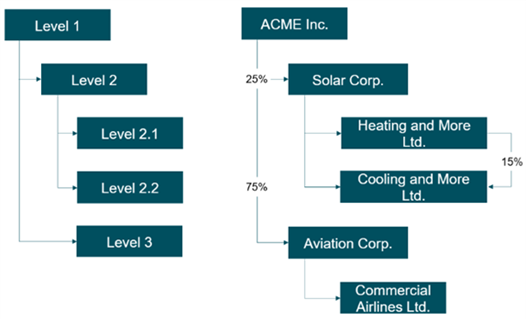
The above example illustrates a legal hierarchy for ACME, Inc.
Industry Characteristics
Industry-specific hierarchies may be characterized by customers that are conducting the same type of business. Industry hierarchies are typically used by the business to categorize customers by type of business using the Standard Industry Classification (SIC). This hierarchy may be used for analytics, i.e., customer/ market segmentation (customer allocated to industry, organizational unit allocated to industry).
The same customer is not typically placed under different locations.
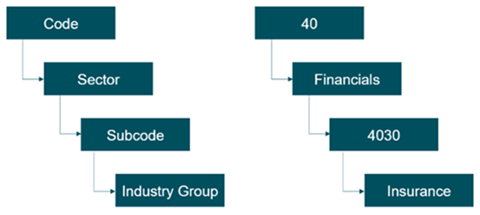
Companies of the same industry are assigned the same SIC code. For example, General Motors, Ford Motor Corporation, Honda, and Toyota were all assigned the SIC code of 3711.
Note: Entities have limited functionality when using in combination with Classifications:
- Entities are not shown as 'sub-products' (or children) of the Classification node
- Attribute values cannot be inherited from the Classification node to the Entity object.
- Classification references to Entities are not inherited from parent Classification to child Classification.
Spatial Location
Location-based hierarchies may be characterized by customers that are allocated at the same spatial location. Location hierarchies are typically used by the business in sales transactions (ordering address), delivery planning (routing), regional revenue reporting, whitespace analysis, segmentation (demographics). This hierarchy may mix different customers under the same location.
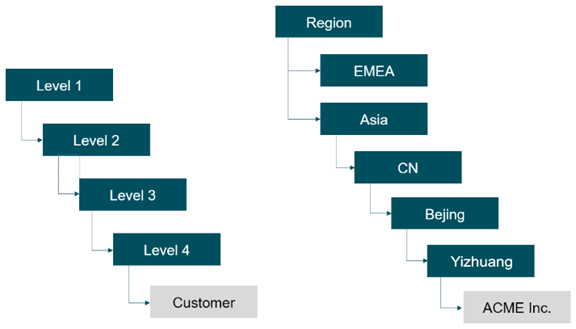
In this example, the hierarchy is purely spatial:
- The Region contains lower categories called 'EMEA' and 'ASIA'
- Below 'EMEA' are the countries of Europe and Middle East
- Below 'ASIA,' are the countries of 'CN,' 'JPN,' etc.
- Below 'CN' could be provinces like 'Beijing' and cities like 'Yizhuang,' etc.
- Below the 'Yizhuang' node are all customers which are allocated on this location
When grouping customers, consider what the usage of the hierarchy is (organizational, legal, spatial, or other). Furthermore, hierarchy names should be designed to organize customers used in that specific context.
Customer hierarchies are a way of structuring customer data so that the data is related to and connected to other objects. This is not the same structuring as with classifications for products, nor will it be the same structure as a web hierarchy where each sales channel has their own web sites. Finally, customer hierarchies are not structured for searching, sorting, and browsing data, though these can be built to apply to customer hierarchies.
Customer Hierarchy Use Cases
Use Case 1 - ACME Group Company Financial Hierarchy
Acme Group consists of fourteen daughter companies across the Americas region. Among these, the relationships across sister companies may or may not exist. In each of these companies there may also exist subsidiaries which operate independently of each other and of the parent company. These subsidiaries are a combination of acquisitions and spin-offs of individual divisions / business units:
- ACME Group - Parent holding company with multiple subsidiary
- ACME Inc - Apparel Manufacturer and Distributor
- ACME Healthcare - Manufacturer and Distributor of healthcare equipment and supplies
- Imaging & IT – Focus on healthcare imaging systems
- Workflow Solutions – Focus on business workflow solutions either as a standalone solution or to compliment an ERP system.
- Diagnostics – Focus on healthcare chemical diagnostic supplies
- ACME Healthcare Supplies LTDA, Brazil - Healthcare Supply Division headquartered in Brazil and caters to South America
- Obits Technologies – Subsidiary focusing on enterprise software
- Obits Financial Services – Focus on financial sector: banking, insurance, wealth management
- Obits Energy Innovations – Think tank for innovations with a focus on energy generation, usage, and consumption
- Wind Power – Leader in wind turbine technology
- Solar & Hydroelectric – Leader in alternative energy solutions for businesses and municipalities
- Oil & Gas – Focus on technology to safely transport crude oil and natural gas
- Energy Service – Energy Solutions Professional Service offerings
- Obits Energy LTDA, Brazil – Energy division headquartered in Brazil and caters to South America
Walter is a Level I analyst for Acme Group, the primary holding company of Acme Inc and all daughter companies and subsidiaries. In alignment with a new initiative, one of Walter’s tasks is to assist with the quarterly reporting for Acme Group. To do so, Walter requires running consolidated (roll-up) reports to provide an aggregate view of all of Acme Group’s holdings and investments.
The challenge that Walter faces today is due to the growing number of holdings and subsidiaries over time, each individual company may have implemented their own accounting solutions to track various performance metrics and KPIs. As such, each company has different views of the truth this makes it very difficult to track and report on the relationships between daughter-to-subsidiary, daughter-to-daughter, subsidiary-to-subsidiary companies.
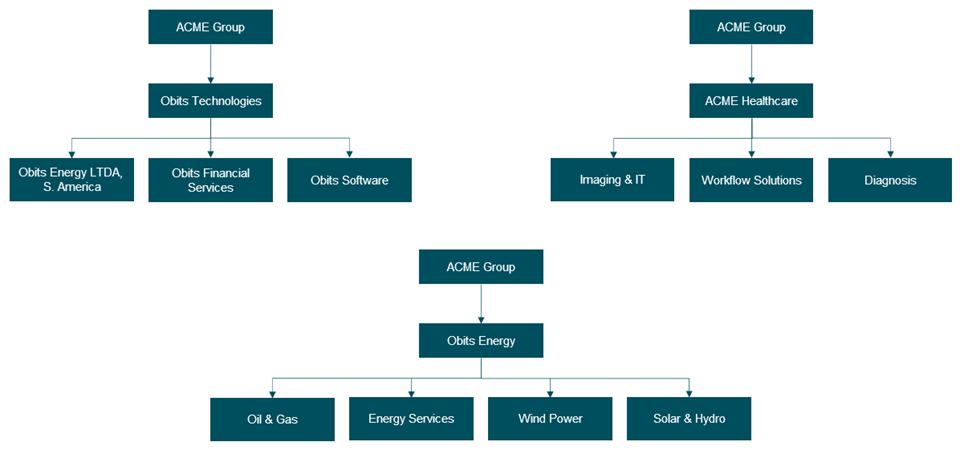
Every quarter, Walter is tasked with generating a quarterly financial report broken down by industry and subsidiaries. However, with no centralized view of the corporate hierarchy and since finances are maintained in separate, isolated ERPs based on industry and divisions. Walter is operationally challenged due to lack of governance.
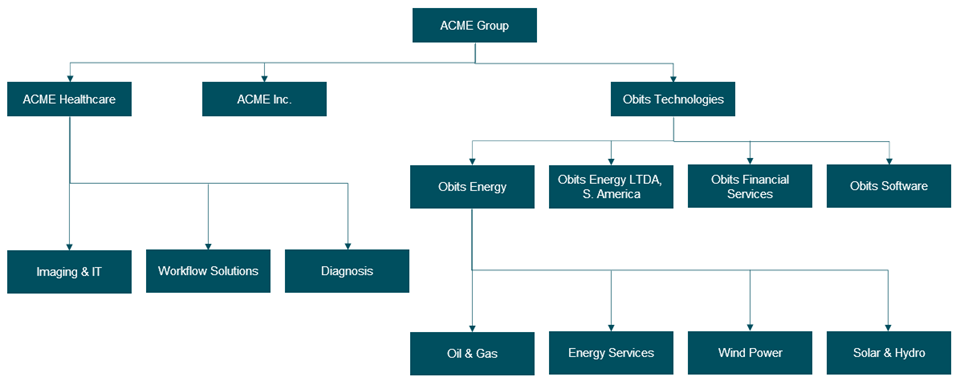
However, in using Customer MDM, Walter is now able to utilize the hierarchy maintenance tools to visualize and maintain a golden hierarchy which models the complete company hierarchy for Acme Group. By taking in consolidating the various information provided by each company’s source system, Customer MDM may now establish the proper relationships between companies within Acme Group.
This golden hierarchy information may be synchronized with Acme Group’s accounting application, so Walter now has an accurate and complete view of all holdings and daughter companies. Walter can confidently select which subsidiaries to be included for various roll-up reports to drive Acme Group’s quarterly analysis.
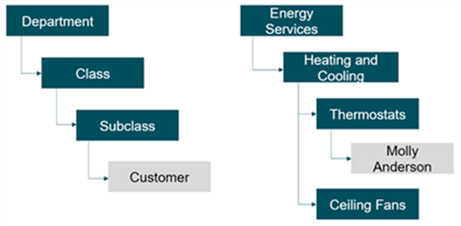
Use Case 2 - ACME Group Company Sales Hierarchy
Whitney, a data steward, is responsible for maintaining internal customer hierarchies at ACME. A new sales manager has been hired to replace a retiree, and Whitney has been asked to update the sales hierarchy. Whitney will need to locate the appropriate territory for the retiree and remove them before adding the new sales manager.
Without a structured internal view, however, ACME struggles with the ability to accurately view and maintain their internal sales structure. To overcome this obstacle, Whitney can use STEP's customer hierarchy capabilities to easily identify the correct region for the new sales manager and create a new entity to represent the sales manager directly below.
With STEP, ACME can now easily view their internal hierarchies, and data stewards are empowered to maintain them.
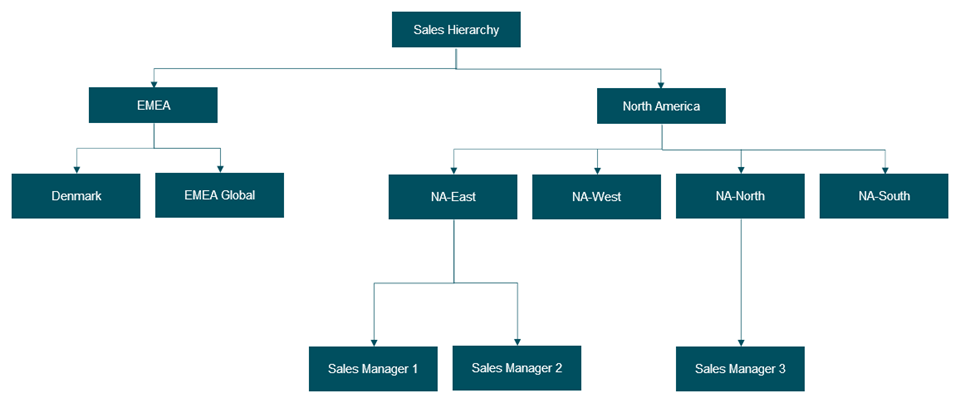
Recommended Practices for Hierarchies
Navigation
The Web UI should be optimized for navigating hierarchies:
- The Global Navigation Panel should include 'Hierarchies' as a Tree Navigator menu item.
- All hierarchy roots should be included in the within the Hierarchies menu item. Customer entities should be visualized within the company hierarchy screen but should not be included in the Hierarchies Tree in the navigation panel.
- A hierarchy tab page should be available on all Details screens for valid hierarchy object types.
Referenced Based Hierarchy
Referenced based hierarchies are structured to where customers reference other customers. Customers that are assigned to higher customer levels specified by the reference type used to appropriate attribution. One benefit of this hierarchy over the parent-child hierarchy is that reassigning a customer does not require related customers to be moved, though the relationship change does apply to them.
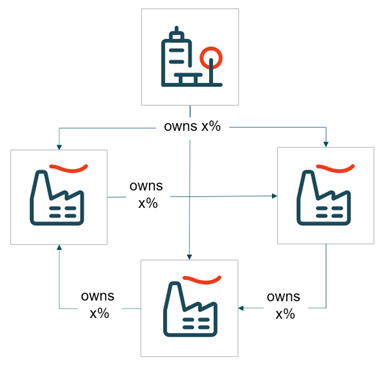
Web Hierarchy
It is recommended to keep the web or sales hierarchy for products clean from customer data. A web or sales hierarchy for products is not intended to be customer specific but rather to represent the product portfolio intended for a specific sales channel.
Customers are typically assigned to a distribution channel in ERP in sales transactions. The distribution channel is an entity through which sales items (products or services) reach customers. They may include wholesale, retail and direct sales. Sales organization is the legal entity that structures the company according to its sales requirements (selling unit) and defines the basic sales and distribution structure. A sales organization is responsible for selling products and services.
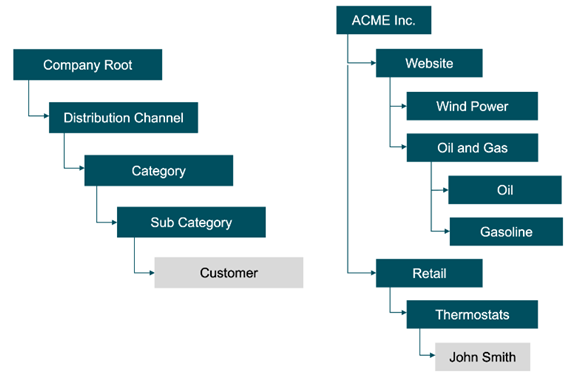
Search Hierarchy
Customer hierarchies is not structured a searching, sorting, or browsing hierarchy. If necessary, these structures may be built in addition to customer hierarchies.
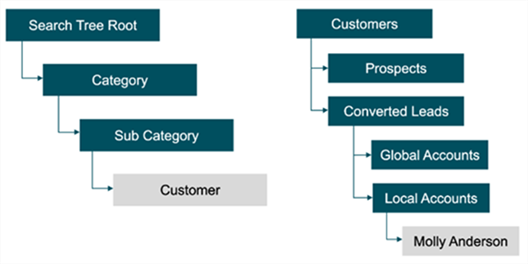
Supplier Hierarchies
The purpose of Supplier-centric hierarchies is for the grouping of supplier entities and maintaining those relationships. Examples of how such hierarchies may be used to support business operations include:
-
Creating, maintaining, and understanding legal relationships amongst supplier entities which may be integral for negotiating pricing and terms, thereby reducing cost.
-
Managing supplier territories for streamlining procurement processes.
-
Supporting cost center roll-ups to track supplier performance.
In the case of creating, maintaining, and understanding supplier legal hierarchies, MDM leverages reputable third-party industry data sources, such as Dun & Bradstreet. By utilizing information provided by D&B’s Detailed Company Profile offering, MDM can identify and relate entities to their Global and Domestic Ultimate Parent companies as well as immediate parent information. This allows for the building out of hierarchical relationships of suppliers within their family structures, boosts purchasing power, and cut costs.